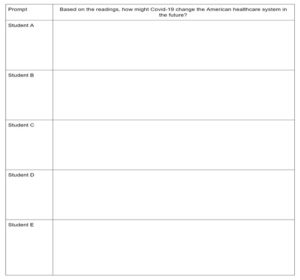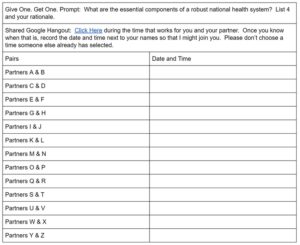Looking at the weeks ahead, especially if you are not a edTech guru and/or your students aren’t accustomed to using, processing, and expressing their learning on X platform or Y application, you may feel overwhelmed or ill-equipped with the task of designing quality distance learning experiences. However, teachers of any discipline who consistently use a core set of Instructional Routines, or Literacy Strategies, in their classroom have done MUCH to prepare students to process and express their learning independently. With a few tech modifications, you’ll find you’ve got the tools you need to provide a manageable and fruitful learning space from a distance.
Below are a few powerful, tried and true, Instructional Routines with a distance learning bend. We are not suggesting you adopt these routines if they are not already familiar to you and your students, rather we provide them as an example to help you think through your existing routines in this new environment.
Though kiddos may know your Instructional Routines like the back of their hand in your physical classroom, there will be some cognitive lift adjusting to the virtual application. So, as always, 1- start with low risk content all learners can access (academically speaking), 2- model what you’re looking for, 3- go slow & repeat!
Go Team!
Silent Conversation: A Writing to Learn Routine

Ideal for students who need an extra bit of process time, students who might be managing multiple languages, or students who are hesitant to speak up- whether in person or virtually- Silent Conversation provides self-monitored wait time along with the power of processing thinking in writing.
Protocol:
- After reading, listening to, or viewing critical content material, small groups of four to five students receive sheets of blank paper, one per student, and a question or statement to prompt student thinking. The question or statement should promote critical thinking, content and personal connections, and deep reflection on key concepts.
- Each student responds in writing to the prompt on their individual sheet.
- After a silent writing period, students silently pass their sheets on to the next student in their group.
- Each student then reads the writing they received, and responds to that writing on the same sheet. These responses can directly address what was written, can share their own thinking, or pose a new idea or question.
- This process continues until all students in the group have read and responded to all individual student sheets.
From a Distance: A shared Google Doc is a great place for this conversation to take place. Keep it simple, put all student group responses in a single Google Doc and preassign student names to portions of the doc. Click Here to see our mock up of a potential template for student use. Giving students a few days to read and write in response to one another, you can get a virtual Silent Conversation going.
Double Entry Organizer: A Reading Comprehension Routine
With kiddos accessing lots of content virtually, including multiple forms of text (videos, articles, etc.) other stand-by routines (i.e. Text Coding & Margin Notes) may be harder for kiddos to use. Reinforce your use of Double Entry Organizer to get students engaged with any text and prepare them for complex use of the content.
Protocol:
- As students engage with a text, they use this two-column organizer to both capture what the text relays as well as their own thoughts, questions, connections, responses and ideas as related to the text.
- Depending on students’ level of familiarity with this tool or the complexity of the text, teachers may chunk portions of the organizer with guiding questions or corresponding sections of text.
From a Distance: As students share devices with siblings and parents, or consume their text via a device, students may very well have the need to support online learning with pen and paper. Have students complete the double-entry organizer “old school” on notebook paper, copy paper, construction paper, whatever they can find! Snap a pic and share with you however is easiest. Ultimately, you being able to read their handwriting isn’t the goal, but their engagement with text is. Check out this double entry organizer template that any Middle or High School student could copy down.
Give One. Get One.: An Academic Dialogue Routine
 A twist on Think.Ink.Pair.Share, in Give One. Get One. students not only come to the conversation prepared, but walk away with new thinking, questions, or learning recorded for later use. When paired with a reflection or outcome that is later submitted to the classroom teacher, you don’t have to worry about “being present” for each of these conversations in order to hold students accountable to the work.Protocol:
A twist on Think.Ink.Pair.Share, in Give One. Get One. students not only come to the conversation prepared, but walk away with new thinking, questions, or learning recorded for later use. When paired with a reflection or outcome that is later submitted to the classroom teacher, you don’t have to worry about “being present” for each of these conversations in order to hold students accountable to the work.Protocol:
- Students are instructed to list a specified number of ideas about the subject at hand and then mix and mingle to share one idea from their list and receive (and record) another idea from a partner’s list until a designated number (i.e. double the number of their original list) is attained.
- To be most effective, students must carry the thinking of the conversation into another task- pairs great with a writing opportunity.
From a Distance: Pair kiddos up, instead of mixing and mingling, they can work with just one partner. Students still come to the conversation with ideas prepared for sharing and still have the opportunity to hear from another classmate and gather more information or ideas. Use a Google Doc Like This One, where partners can submit a date and time when the two of them can meet and chat- you can then join as your schedule permits. The entire class can use the same Google Hangout Link (perhaps set to a Saturday or Sunday to keep from blocking your calendar). As long as all the pairs know they have a few days to find an available time, kiddos have access to enter and leave the Google Hangout as they need. If two sets of partners accidentally double up at the same time, so be it. Four heads are better than two.
